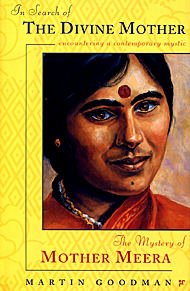
In Search of the Divine Mother: The Mystery of Mother Meera - Encountering a Contemporary Mystic. Martin Goodman
In Search of the Divine Mother by Martin Goodman is a very human attempt to understand the mystery of the incarnation of the Divine. Christians claim this mystery to explain how Jesus, a man born of woman, was also the Christ: God come to Earth to redeem humans of sin. The gospels of the New Testament are the Christian story of how this happened 2,000 years ago. Mr. Goodman took as his starting point Mother Meera, a woman born in 1960 in the Andhra Pradesh region of India who claims to be an avatar (or incarnation) of the Hindu goddess the Divine Mother.
The book is in three parts. In the first part, "A Journey into Devotion" we learn how Goodman and others receive "darshan" (being in the presence of God) from Mother Meera in her home in the small German village of Thalheim where she has lived since 1985. "Her darshan consists of a ritual, where she will touch a person's head, and then look into his eyes. During this process, she reportedly 'unties knots' in the person's subtle system and permeates him with light. She doesn't charge any money for doing so and she will not give lectures." -- WIKIPEDIA.
The second and main part of the book is called "The Life Story." Goodman was encouraged by Mother Meera and her followers to go to India and to write a book about her life. They gave him a list of contacts and he went. He interviewed these people and others who knew Mother Meera, Venkat Reddy, the uncle who discovered her, and Adilakshmi, her devoted friend and follower. Among those he interviewed were Mr. Reddy's family, whom he left to pursue his devotion to the child-god he had found among them. Here Goodman explores the question of how the Divine manifests itelf in the human. Does the human know of their divinity from birth? How does their divinity manifest itself on the material plane? How does a very human creature respond to their divine nature? How do others, who have no knowledge of the Divine, interpret the divine spark in someone they know? These are difficult questions that are not easily answered in the limited vocabulary of human discourse. Goodman makes a valiant attempt yet, as with all writing, we see more of the author than what he is trying to describe.
The third part "A Journey into Life" tells of his attempts to get his words published. Mother Meera and Adilakshmi ask him to delete his first draft and he complies. He struggles with his decision and, in anger, writes a second draft which is also never published. The book we have is a later draft and this last chapter is his attempt to come to terms with his contact with the Divine. He sums up by saying: "Mother Meera gives powerful spiritual transmission that helps people bud into the fullness of life.... I have met a power that comes from Mother Meera, and it has transformed my life. It did not come from her words but from within the silence of her public meetings. ... It is wonderful to know her through her silence alone." He sees her as "a superb channel" of the Divine, that the Divine energy flows through her human form to those who approach her. Yet he seems to be saying that she maintains human form and does not transcend it.
Goodman's devotion to Mother Meera helped him to come to terms with his own homosexuality, something that was also stated by her first biographer Andrew Harvey in his book Hidden Journey. Her unconditional love and silent acceptance were very healing to both men. When her 1997 book Answers Part 2 states that "Homosexuality is against the law of nature," both men are shaken from their devotion. Goodman states: "...since I know with certainty that Mother Meera is wrong in her condemnation of homosexuality, I cannot accept her word on anything else."
This is a wonderfully honest attempt to write about the human experience of the Divine. It will be insightful reading for any who are interested in spiritual growth.
No comments:
Post a Comment